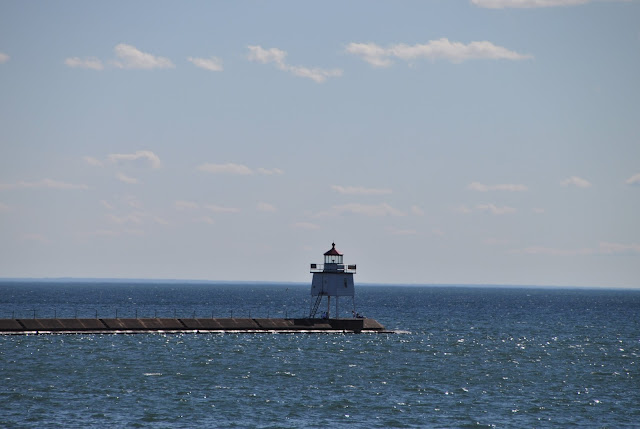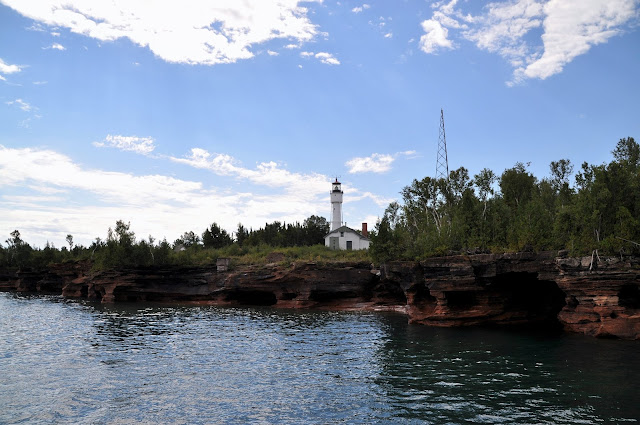Superior Entry Lighthouse with fog trumpets in 1915
(Photograph courtesy of U.S. Coast Guard)
Superior Bay is a natural harbor in the northwest corner of
Lake Superior that is fed by the St. Louis River and empties into the lake
through a natural opening, known as Superior Entry, which is bounded by
Minnesota Point and Wisconsin Point. Together, these two points create the
longest freshwater sandbar in the world. On June 30, 1906, Congress
appropriated $20,000 for range lights to mark the new south pier, after the old
ones were washed away in 1905. But, after this appropriation, the Superior Entry
project was expanded to include not only new parallel piers but also two
converging breakwaters to protect the entrance. The Lighthouse Board requested
an additional $25,000 to cover a light and fog signal on the southern
breakwater, and three non-attended acetylene beacons to mark the piers and
northern breakwater. Congress provided this amount on March 4, 1911, and work
on the new lighthouse commenced that fall. The Superior Entry Lighthouse went
into commission on October 10, 1912 at the outer end of the southern
breakwater. This two-story structure is oval in plan and situated on a concrete
pier that rises eleven and a half feet above the concrete breakwater. The
circular tower rises from the outer end of the lighthouse, and is surmounted by
a cast-iron deck and fourth-order helical bar lantern, from which an occulting
white light was exhibited by a fourth-order, Sautter, Lemonier, & Cie. Drum
lens at a focal plane of seventy feet. A clockwork mechanism, powered by a
seventy-five pound weight that was suspended in a drop tube and had to be wound
up every four hours, revolved a screen inside the lens to produce the light’s
characteristic: five seconds of light, followed by five seconds of eclipse. The
concrete pier underneath the lighthouse provided storage for oil, paints,
gasoline, and water. The first story of the lighthouse, also of concrete,
housed the twenty-two horsepower air compressors and tanks, a heating plant, a
bathroom, and cold storage room. The lighthouse’s second story, made of wood,
contained a kitchen, living room, three bedrooms, and a bathroom. An additional
assistant was authorized for the station, after a fourth light besides the main
light on the south breakwater was established at Superior Entry. These four
lights were a fifty-foot skeletal tower on the north breakwater, a twenty-five
foot skeletal tower on the north pier, a twenty-five foot skeletal tower on the
south pier, and a light on the inner end of the south pier. A radio beacon was
established at Superior Entry in 1938. The station was automated in 1970, when
a DCB aerobeacon was installed in the lantern room. On May 1, 2013, the General
Services Administration announced that the Wisconsin Point Lighthouse was
excess to the needs of the Coast Guard and was “being made available at no cost
to eligible entities defined as federal agencies, state and local agencies, and
other non-profit, historic, or community purposes.




















































